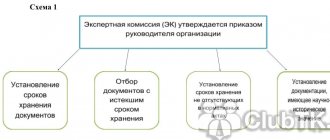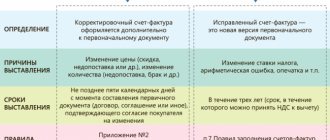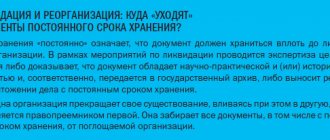Issues discussed in the material:
- What is personnel records in an organization and why is it needed?
- HR documents
- Who can be entrusted with maintaining personnel records in an organization?
- How to set up HR records in an organization from scratch: step-by-step instructions
- What errors may occur when maintaining personnel records in an organization?
- What other errors can a GIT inspector detect when checking the organization of work on personnel records?
- Who is responsible for violations in the personnel records system in the organization
- Why should you entrust personnel accounting and personnel records to a consulting company?
Personnel records in an organization allow you to reliably reflect information that not only demonstrates the transparent activities of the company, but also helps it function fully. This work involves the preparation of a huge number of different documents - from personal files of employees to the creation of labor discipline rules, so maintaining personnel records is simply impossible to ignore.
Undoubtedly, maintaining such a volume of documentation requires regulation, the standards of which are established at the legislative level. However, just knowing how personnel records should be maintained in an organization is not enough. And therefore we will tell you where to start in order to avoid mistakes that can lead to large fines.
What is personnel records in an organization and why is it needed?
Personnel records are a set of measures aimed at regulating the labor relationship between employer and employee. An organization's personnel are its main value and main resource. Therefore, it is very important to be able to build an effective personnel records system in an enterprise. To do this, you need to understand the current legislation and have certain competencies.
Properly selected HR personnel will allow the company to minimize the possibility of errors and serve as a guarantee of protecting the rights of its team.
Personnel accounting is a mandatory component of the activities of any organization.
The responsibilities of HR department employees include:
- hiring workers;
- dismissal of employees;
- registration of horizontal (transfer between departments) and vertical (career growth) movements;
- travel arrangements;
- sick leave records;
- filling out time sheets;
- vacation registration;
- filling out personal cards of employees, etc.
Personnel records in a budgetary organization include:
- military registration;
- regulation of labor relations;
- development, implementation and registration of personnel documentation (hiring orders, employee incentives, etc.);
- labor organization and other issues.
All company documentation must be prepared in accordance with applicable regulations. This rule applies to both unified documents and local ones (developed by the organization itself).
Correct construction of personnel records allows you to solve most of the company’s problems and tasks related to personnel.
Collaboration and document storage
HR document flow does not exist in a vacuum, being part of the company’s business processes. In addition to the payroll and accounting departments, employees of the labor protection, regulation, and personnel selection departments interact with personnel officers. Interaction through paper documents or various Word files can lead to their loss or asynchronous maintenance when, for example, one department uses the current list of personnel transfers at the beginning of the month, and another uses the previous version of the document.
HR software allows you to store all documents in one place, as well as regulate the access and priority of employees to edit them, thus maintaining the relevance of the data. For example, in the system you can give the head of the labor protection department access to hiring, and the labor regulation department can restrict access to sick leaves or vacations of employees.
HR documents
There are mandatory and optional documentation included in personnel records in an organization. The documents required for use are determined by the Labor Code of the Russian Federation.
These include:
- employment order (T-1);
- contract (agreement) with an employee (TD-1);
- work book (mandatory use is established by Decree of the Government of the Russian Federation No. 225 “On work books” dated April 16, 2003);
- employee personal card (T-2);
- translation documents (T-5);
- order for registration of leave (T-6);
- vacation schedule (T-7);
- staffing (T-3);
- time sheet (T-12);
- dismissal order (T-8).
All the documents listed above have a unified form. The rest of the personnel documentation is developed by the organization itself.
Optional documents include:
- collective agreement;
- inner order rules;
- wage regulations;
- provisions on personal data of employees;
- labor protection regulations;
- bonus provisions.
However, labor legislation protects hired personnel, therefore the use of local regulations in an organization that infringe on the rights of employees is unacceptable. This point is regulated by Article 8 of the Labor Code of the Russian Federation.
Accounting documents are developed by employees of the enterprise's personnel service. After this, the head of the company checks and approves them. Next, employees familiarize themselves with the document under the personal signature of each.
Top 3 articles that will be useful to every manager:
- How to choose a tax system to save on payments
- How to minimize taxes and not interest the tax authorities
- How to create an electronic signature quickly and easily
The preparation of some personnel documents is optional in cases where the information that should be reflected in them is already included in other personnel documents. For example, there is no need to draw up a job description if all the employee’s functions are specified in the employment contract. The same is true with regard to wages. It is optional in the case where all essential payment conditions are contained in the contract with the employee.
The need to create one or another personnel records document is determined by the specifics of the organization’s activities and the functionality of a particular employee. Thus, a shift schedule is necessary only for those companies whose employees perform their functions in shifts. Regulations on trade secrets, documents regulating access (and its termination) to it and responsibility for its disclosure must be drawn up at high-secrecy facilities. An agreement on full financial responsibility is signed with an employee whose responsibilities include ensuring the safety of material assets.
Personnel accounting. Why does business need HR records?
Complete list of personnel documents for legal entities in 2021
This list includes important instructions, schedules, rules and orders.
According to the current requirements of the Labor Code, the list of personnel documentation that legal entities are required to maintain includes:
- labor regulations within the company;
- documents on the protection of personal data;
- company staffing table;
- employment contracts with each full-time employee;
- job descriptions for each position;
- work books and a log of their movements;
- regulations on salaries, training and routine certification of specialists;
- time sheet for working hours and days off;
- schedules of vacation periods for each hired employee;
- orders for the admission, transfer, dismissal of an employee, granting him leave, as well as books for recording such orders;
- orders on the main activities of the enterprise;
- personal cards for each full-time employee (form T-2);
- agreements on financial liability of a full-time employee;
- book of registration of inspections of the controlling department;
- minutes of meetings;
- safety instruction books;
- log of mandatory medical examinations;
- book of acts about accidents.
All of the above administrative documents accompanying the implementation of labor activities are included in the list of mandatory personnel documents that must be correctly executed in the LLC.
In the event that a resident of a foreign state is included in the staff of the enterprise, the list of mandatory personnel documents is supplemented with a notice of signing an employment contract with a foreign citizen.
Who can be entrusted with maintaining personnel records in an organization?
Personnel records in a company can be organized in several ways. They all have their advantages and disadvantages. Let's look at them in more detail.
| Method of organizing personnel records | Advantages | Flaws |
| Hiring a full-time HR specialist |
|
|
| Involvement of a third-party specialist (upon recommendation) |
|
|
| Delegation of accounting to an accountant or secretary |
|
|
| Delegation of personnel records to a third party |
|
|
The main advantages of outsourcing HR records
- The main reason for outsourcing in any field of activity is cost reduction. The organization pays a fixed amount and “forgets” about all the additional costs for the personnel service.
- Risk reduction. By outsourcing HR records, an organization can afford not to follow constant innovations in legislation. Changes in labor law will become a “headache” for an outsourcing company, as will the specifics of their application in personnel records management. Therefore, the possibility of “earning” a fine will be significantly reduced.
- Professional experience. Companies offering outsourcing services use proven and effective methods. Therefore, you can easily take advantage of their experience and improve your management system using the most modern methods.
- Support anytime. Employees of their own personnel department must be released for legal rest or training. Also, full-time employees get sick, go on maternity leave, or may quit unexpectedly. The outsourcing company’s specialists, of course, also sometimes “disconnect” from the work process, but they are interchangeable, so not a single client will be left without help.
- Consistency of personnel records with other services. As a rule, contracting companies employ not only HR specialists, but also employees of legal and financial departments. Thus, emerging problems are resolved with the support of specialists from “related” fields of activity.
How to set up HR records in an organization from scratch: step-by-step instructions
A manager can always organize accounting in an organization, even if there is no experience. To do this, you just need to act in accordance with a certain algorithm. Personnel accounting in an organization from scratch looks step by step as follows.
Step 1: Learn the basics of HR.
In addition to the latest edition of the Labor Code of the Russian Federation, it is necessary to study regulations in the field of labor law and comments to them. These documents already contain most of the answers to questions in the field of labor relations. Insufficient knowledge of labor legislation entails mistakes when working with personnel, and, consequently, bringing the organization to administrative responsibility.
Step 2: Find out what computer programs you can use.
To make work easier, specialized programs can be used to maintain personnel records in an organization. They allow you to minimize routine operations and optimize work with documents. Processes such as recording actual time worked, creating vacation schedules, and drawing up orders and instructions are automated.
Instructions for personnel records management 2021 - download or develop yourself?
The instructions for personnel records management have not been normatively approved, therefore, for maintaining personnel records and document flow, it is recommended to follow GOST R 7.0.8-2013, approved by Order of Rosstandart dated October 17, 2013 No. 1185-st and put into effect on March 1, 2014.
There is no single template for instructions on personnel records and office work, but there are personnel records from scratch step by step with recommended stages for organizing personnel document flow and accounting in an enterprise. Thanks to this step-by-step plan, it is easy to identify the sequence of actions and navigate the amount of work.
We recommend that you read the step-by-step instructions below that will help you organize HR records from scratch. In the future, based on the material studied, you can develop your own action plan and follow it.
What errors may occur when maintaining personnel records in an organization?
If regulatory authorities discover violations in the field of personnel records, the organization is held accountable (administrative or criminal).
The following are typical violations.
1. Mistakes when working with personal files
A personal file for an employee is opened at the moment he is hired for a position and is maintained until dismissal.
When filling out personal files, the following errors occur:
- lack of necessary documents;
- violation of the order of documents;
- lack of personal files as such;
- reconciliation is not carried out in a timely manner;
- filling out an employee questionnaire instead of a personal record sheet;
- entering unnecessary documents;
- non-compliance by HR employees with the procedure for transferring personal files to third parties (companies).
If the personal files of employees are formed properly, this makes working with them much easier. Properly organized storage allows you to ensure the integrity of documents and quick access to them.
2. Errors when drawing up an employment contract
In the event of labor disputes, mistakes made by the employer when concluding or terminating contracts with employees can have quite serious consequences for the company.
Errors may be:
- signing one copy of the contract;
- the employment contract has not been registered or the registration date has not been entered;
- no signature on employment contracts;
- mandatory information and/or conditions are missing;
- no employment contract has been concluded;
- one of the copies of the employment contract was not given to the employee or there is no receipt mark;
- the duration of the contract has not been determined;
- the conditions for completing the probationary period (if any) are not specified;
- the employee’s salary, the date of its payment, the method of payment, the working hours and the duration of leave are not indicated.
AUTOMATED WORK WITH PAPER DOCUMENTS
First, let's look at how you can use electronic document management systems when working with paper documents.
HR Dictionary Document flow - the movement of documents in an organization from the moment of their creation or receipt until completion of execution or dispatch
The HR department processes the following documents:
- incoming (coming from other organizations);
- outgoing (sent to other organizations);
- internal (created in the organization for use in management processes).
The peculiarity of personnel documentation is that they are mainly internal documents.
The process of working with documents of all types comes down to their transfer from one official to another, i.e., in fact, to their movement within the company along a certain route:
- incoming - from receipt to execution;
- outgoing - from creation to sending;
- internal - from creation to execution. When moving documents, certain procedures are followed,
- the set of which depends on the type of document. Some of them can be automated.
What document processing procedures can be automated?
First of all, approval of draft documents, registration, control of execution and search in the electronic document management system.
Let us note the main features of the implementation of these procedures in relation to personnel documentation.
1. Electronic approval of documents.
The need for approval of documents arises when preparing orders for personnel, submissions and proposals for transfer to another job, rewarding employees and in many other cases.
Preparation of personnel documents in an automated mode allows you to avoid the labor-intensive and time-consuming procedure of traditional approval using duplicate copies of the draft document.
Having the responsible executors have an electronic signature allows you to abandon the “paper” approval of documents and speed up the process of their preparation and acceptance.
How to organize electronic approval of documents?
The electronic document management system must include a list of documents subject to approval, indicating the following mandatory information:
If the organization has a representative body of workers, for example, a trade union committee, the above list should indicate all cases provided for by the Labor Code of the Russian Federation for issuing documents on issues of working with personnel that require taking into account the opinion of the trade union committee (another representative body of workers).
2. Registration of documents.
Registration of personnel documents is traditionally carried out using books, registration journals, and record cards listed in Art. 695 List of standard administrative archival documents generated in the process of activities of state bodies, local governments and organizations, indicating storage periods, approved. by order of the Ministry of Culture of Russia dated August 25, 2010 No. 558 (hereinafter referred to as the List of documents with storage periods).
What registration forms can be maintained electronically?
Most of the personnel documents can be taken into account in an automated mode. The only exceptions to this rule are those registration forms that provide for the personal signature of a personnel service employee after entering information about the document and (or) the signature of an organization employee upon receipt of the document - for example, a book for recording the movement of work books and inserts in them.
Forms of registration books, magazines, cards are developed and approved by the employer independently. However, in some cases, registration forms established by regulatory legal acts must be used:
- a book for recording the movement of work books and inserts in them, as well as a receipt and expenditure book for accounting for forms of a work book and inserts in it, the forms of which are attached to the Instructions for filling out work books, approved. Resolution of the Ministry of Labor of Russia dated October 10, 2003 No. 69;
- NA No. 12'2009 is a logbook for employees leaving on business trips from the sending organization, and a logbook for employees who arrived at the organization to which they are sent, the forms of which are approved by order of the Ministry of Health and Social Development of Russia dated September 11, 2009 No. 739n.
How to automate the document registration process?
The corresponding registration forms with instructions for completing them must be included in the electronic document management system. Let us give examples of such forms.
Electronic registration of documents allows you to subsequently search for information about working with personnel and compile analytical reports and statistical reports in an automated mode.
Since the establishment of our company, personnel records have been kept in paper journals and registration books. Starting next year, we want to switch to automated registration and have transferred the existing registration forms to spreadsheets. This work also made it possible to verify that we have some problems with the numbering of personnel documents. I would like to build a logical and competent system for registering them. Are there any rules according to which documents must be assigned registration numbers?
When building a system for registering personnel documents, you really need to pay attention to their indexing (numbering). This issue is not regulated by regulations and is decided by the employer, but it is advisable to take into account the following recommendations.
1. Employment contracts are registered within a calendar year.
For indexing, simple serial numbers are used, to which, in order to speed up the search for documents, you can add: the year when the employment contract was concluded, the index of the structural unit to which the employee was hired, etc.
2. Orders for personnel are registered and indexed separately depending on the period of their storage.
Most personnel orders have a long shelf life of 75 years. The exception is orders with a retention period of 5 years: on the provision of annual paid and educational leave, on the secondment of employees within the country, on the imposition of disciplinary sanctions, on duty (clause “b” of Article 19 of the List of documents with retention periods).
In established practice, the method of alphanumeric indexing has been used for many years, when a letter designation is added to the serial number of the order, for example 1-k, 1 l / s, etc. In the case of a large number of orders for personnel, when registering, they are divided not only by storage periods, but also by variety (subject-specific basis): about hiring, about transfer to another job, about dismissal, etc. Each array is assigned its own alphanumeric index.
3. When registering employee personal cards and personal files, different methods can be used - for example, documents and files are assigned simple serial numbers, and newly hired employees “inherit” the numbers of personal cards and personal files of those who quit (similar to assigning personnel numbers to employees). Often, the employee’s personnel number is simply used to number personal cards and personal files.
4. Statements, acts, protocols, internal correspondence (reports and explanatory notes) are numbered within a calendar year using simple sequential numbering.
5. Official letters, as a rule, are registered centrally with the assignment of indexes built according to the following scheme: the serial number of the document from the beginning of the calendar year and the number of the file in which the executed received document will be filed in the future, or the number of the file in which a copy of the sent document will be placed .
Note! Not all registration books (magazines) can exist only in electronic form
As already mentioned, registration forms for personnel documents are included in the List of Documents with Retention Periods.
Books of registration of employment contracts, personnel orders (with a long shelf life), personal files, personal cards of employees, etc. are stored for 75 years.
Therefore, they cannot exist only in electronic form. When working with such registration forms, you should adhere to the following rules.
Rule 1. At the end of the calendar year, electronic registration books (magazines) must be printed page by page and bound in hard or soft covers, depending on the storage period, which is equal to the storage period of the documents registered in the book (magazine).
Rule 2. All registration forms, regardless of shelf life, must be stitched and not glued or fastened with metal staples. The pages of books (magazines) are numbered before using the form.
Rule 3. Books (magazines) in which documents of long-term (over 10 years) and permanent storage periods are recorded are not only stitched and numbered, but also laced and then certified. The certification inscription indicates in numbers and in words the number of stitched and numbered sheets of the book (magazine). The certification is made by the head or specialist of the personnel service and is certified by the seal of the personnel department. In its absence, the certification signature is made by the head of the organization or a person authorized by him and certified by the seal of the organization.
What features of registration forms are established by regulations?
Special requirements are imposed on the book for recording the movement of work books and inserts in them and the receipt and expenditure book for recording forms of the work book and inserts in it. According to clause 41 of the Rules for maintaining and storing work books, producing work book forms and providing them to employers, approved. By Decree of the Government of the Russian Federation of April 16, 2003 No. 225 “On work books”, these books must be numbered, laced, certified by the signature of the head of the organization, and also sealed with a wax seal or sealed.
3. Control of execution of documents.
Of great importance for the personnel service is monitoring the execution of documents, as well as monitoring compliance with the requirements of the Labor Code of the Russian Federation when working with personnel.
When an employee is actually admitted to work, the employer is obliged to draw up an employment contract with him in writing no later than three working days from the date of the employee’s actual admission to work (Part 2 of Article 67 of the Labor Code of the Russian Federation). The employer's order for employment is announced to the employee against signature within three days from the date of actual start of work (Part 2 of Article 68 of the Labor Code of the Russian Federation).
When an employee is actually admitted to work, the employer is obliged to draw up an employment contract with him in writing no later than three working days from the date of the employee’s actual admission to work (Part 2 of Article 67 of the Labor Code of the Russian Federation). The employer's order for employment is announced to the employee against signature within three days from the date of actual start of work (Part 2 of Article 68 of the Labor Code of the Russian Federation).
What other errors can a GIT inspector detect when checking the organization of work on personnel records?
The State Labor Inspectorate periodically conducts on-site inspections. The organization is given ten days to prepare.
Errors that are most often detected during testing are shown in the table.
| Error | How to fix |
| The internal labor regulations do not contain information about the employer's responsibility. | The detection rate of such an error during a routine check is 90%. It can be corrected by issuing new PVTR, which will contain a chapter on the disciplinary and financial responsibility of the manager. |
| Workers are not familiar with the LA directly related to their work activities. |
|
| The documents do not contain information about wage indexation. | Development of additional agreements to employment contracts. |
| Ignoring the opinions of trade unions when developing aircraft. | Creating a new document. |
| The PVTR does not specify a second day off and/or paydays. | |
| Lack of information in the employment contract about the employee’s salary, regional coefficient, percentage bonus for workers in the Far North. | |
| The employment contract does not specify SOUT. | If a special assessment of working conditions has been made, this must be reflected in the contract. Otherwise, it is worth adding the phrase “Working conditions will be determined by the SOUT, it will be carried out within the time limits established by law.” |
| The working time sheet is filled out incorrectly: there is no information about working overtime and holidays, the length of the working day is incorrectly indicated, there is no information about absenteeism and tardiness. | Create a correction sheet and enter the correct information into it. |
| Incorrectly drawn up vacation schedule: the transfer is not reflected, the fact that the employee familiarized himself with the order 2 weeks before the vacation is not recorded, preferential categories are not taken into account, the vacation is incorrectly divided (one part must last at least 14 days). | Creating a new schedule, generating vacation notices (must be signed by employees). |
| Lack of occupational safety instructions for employees working on PCs | Employers often forget that when working at a computer for more than four hours, it is necessary to comply with labor safety rules. Appropriate instructions must be developed, and employees must be familiarized with them under signature. |
Shortcomings in the documentation associated with incomplete completion of fields or the absence of a mandatory signature are very annoying. Therefore, it is necessary to carefully check all the papers and enter the necessary information even before the visit of the State Tax Inspectorate, who apply separate sanctions for each violation (three errors - three fines).
List of mandatory personnel documents for micro-enterprises
The list of required documents for a micro-enterprise has been reduced by several points compared to a large corporation
Micro-enterprises that employ up to 15 people and whose annual turnover does not exceed 120 million rubles are eliminated from the need to prepare some personnel documents. Thus, according to Article 309.2 of the Labor Code of the Russian Federation, the following are optional for a microenterprise:
- specialists' work shift schedules;
- regulations on wages and bonuses for employees;
- internal labor regulations;
- other local documents regulating labor relations.
Due to the possible absence of local acts regulating labor relations in the company, all key provisions of this process must be declared in the employment agreement between the employer and the employee.
Who is responsible for violations in the personnel records system in the organization
The State Labor Inspectorate is the body that monitors the correct maintenance of personnel records in organizations. If State Labor Inspectorate employees discover violations, they have the right to hold the employer accountable for non-compliance with labor laws.
Based on the norms of Article 419 of the Labor Code of the Russian Federation, the following types of liability can be distinguished:
- Administrative responsibility
Penalties for officials and companies are regulated by Articles 5.7, 5.27–5.34, 5.39 of the Code of the Russian Federation on Administrative Offenses. As a rule, employers are brought to this type of liability in the absence of any necessary personnel document or refusal to provide it at the request of an employee (organization).Let’s say Petrenko V.A. intends to take out a loan, and he needs a copy of his work record book, as well as a 2-NDFL certificate. He turned to his employer with a request to give him a copy of his work record book and received a negative response. In this situation, Petrenko V.A. has the right to contact the State Tax Inspectorate and report the employer’s unlawful actions. The inspection, in accordance with Article 5.39 of the Code of the Russian Federation on Administrative Offences, will hold the organization's officials accountable and impose a fine in the amount of 1,000 to 3,000 rubles.
- Civil liability
Defined by articles 15, 151 and 59 of the chapter of the Civil Code of the Russian Federation.Let's look at an example. Korpenko Yu. S. was injured at work. According to Article 1085 of the Civil Code of the Russian Federation, the employer must pay him for the time he is on sick leave and compensate for the costs of treatment and recovery.
- Criminal liability
Provided for in Articles 143, 145,145.1,146, 147,215, 216, 217 of the Criminal Code of the Russian Federation.Personnel documentation may also be required by Federal Tax Service employees. Failure to provide it entails punishment under Article 126 of the Tax Code of the Russian Federation.
Personnel policy and personnel document flow of the organization
The existence of any organization is impossible without document management. Already at the planning stage of any organization, a person is faced with the preparation and execution of primary documents, such as a business plan, state registration certificates, documents prepared by the tax authorities, etc.
Further, along with maintaining current documentation of a company or organization, in accordance with current legislation, personnel document flow is also maintained, ensuring the organization of work on personnel management. To effectively organize this work, a clear understanding of the personnel policy pursued in the organization is necessary.
Personnel policy is the general direction of personnel work, a set of principles, methods, forms, organizational mechanisms for developing goals and objectives aimed at preserving, strengthening and developing personnel potential, creating a qualified and highly productive team capable of promptly responding to constantly changing market requirements, taking into account strategic development of the organization and strategy for managing its personnel.
Based on the definition, we can conclude that the main goal of personnel policy is to create a personnel management system based primarily not on administrative methods, but on economic incentives and social guarantees aimed at bringing together the interests of the employee and the organization, achieving high labor productivity, increasing production efficiency.
The main task of personnel policy is to ensure conditions for the implementation of current legislation in the field of labor relations.
The concept of personnel records and document flow
Each organization that hires workers enters into formal labor relations with them. Hiring and dismissal, payment of wages and going on vacation - all this is accompanied by paperwork. And they must strictly comply with the law.
For the orderly operation of the company, it is necessary to maintain personnel records.
Large organizations employing a large number of people form a human resources department for such tasks. But personnel records are no less important for an individual entrepreneur. An individual entrepreneur must maintain it if he hires workers. It doesn’t matter how many people work for him, the main thing is that they exist. An individual entrepreneur must maintain personnel records and document flow on a par with LLCs and enterprises of other forms of ownership.
Personnel records are records of the activities of all employees holding certain positions in the company. It is necessary to organize legal and most effective labor relations between employee and employer.
Document flow in the field of personnel is the preparation and movement of documents recording data about employees and their working conditions, in particular the calculation of salaries, the formation of a working time schedule, etc.
Depending on what the company does, accounting will have its own specific features. But there are forms that are mandatory for all areas of activity. They are regulated by the regulations of our country.
Document flow in the organization is carried out in accordance with the regulatory framework
Table: legislative acts on personnel document flow
| Name of the legislative act and date of its approval | Characteristics of the document from the point of view of office work |
| Labor Code of the Russian Federation (December 21, 2001) | Establishes what documents are necessary to formalize labor relations (hiring, termination of a contract, vacation, etc. in Articles 67, 68, 84). Declares the need to establish internal labor regulations and apply vacation schedules (Articles 123, 190). The deadlines for processing documents and the procedure for familiarizing employees with them are also discussed here (Articles 14, 67, 68). |
| Decree of the Government of the Russian Federation “On work books” (No. 225 of April 16, 2003); Resolution of the Ministry of Labor and Social Development of the Russian Federation “On approval of instructions for filling out work books” (dated October 10, 2003 No. 69). | Consider issues of form, maintenance and storage of work books, as well as inserts in them. |
| All-Russian classifier of worker professions, employee positions and tariff categories OK 016–94 (OK PDTR). | Encodes data about employees, for example, information about education, position, etc. It is used to fill out a number of accounting forms (T-2) used in the personnel department. |
| Federal Law “On Information, Information Technologies and Information Protection” (dated July 27, 2006 No. 149-FZ). | Defines what documented information is. In state bodies and local governments, documentation of information is carried out in accordance with the rules of office work established by the federal government authority in the field of archival affairs and office work. |
| Federal Law “On Joint-Stock Companies” (Article 89) and Federal Law “On Limited Liability Companies” (Article 50). | Determines the responsibilities of companies regarding the storage of documents and their composition. Establishes the mandatory storage of documents in the organization, and in some cases, their transfer to state storage. “The society is responsible for organizing documents and must carry out work to preserve them in accordance with the instructions and recommendations of the archival authorities of the Russian Federation.” |
| Order of the Ministry of Culture of Russia “On approval of the “List of standard management archival documents generated in the process of activities of state bodies, local governments and organizations, indicating storage periods” (dated 08/25/2010 No. 558). | Contains a list of standard management archival documents indicating storage periods, provisions on staffing, as well as accounting and reporting. |
| Resolution of the State Statistics Committee of the Russian Federation “On approval of unified forms of primary accounting documentation for accounting of labor and its payment” (dated 01/05/2004 No. 1). | Contains instructions on the use and completion of forms for recording primary documentation for labor accounting and payment. |
| GOST R 6.30–2003 “Unified system of organizational and administrative documentation. Documentation requirements." | Is of a recommendatory nature. Determines the general requirements for the preparation of documents and the composition of their details. |
| Federal Law of July 27, 2006 No. 152-FZ “On Personal Data”. | Regulates relations related to the processing of personal data by legal entities with or without the use of automation tools. Determines the procedure for receiving, storing, processing, using and transferring personal data of employees (including). |
Other regulations
In addition to the laws mentioned above, the following are used in the field of personnel work:
- Law on consideration of appeals from Russian citizens No. 59-FZ dated 02.05.06.
- Law on the state language of the Russian Federation No. 53-FZ dated 01.06.05.
- Law on Trade Secrets No. 98-FZ dated July 29, 2004.
- Basic rules for the work of archives of organizations (approved by the decision of the Board of Rosarkhiv on February 6, 2002).
- Unified qualification directory of positions, managers, specialists and employees.
Software for HR document management
To optimize the work of the HR service in the face of increasingly complex document flow, software is used. It can be basic, including an operating system, an office suite, tools for working on the Internet and with e-mail, etc. The standards are versions of software from Microsoft (Microsoft Windows as an operating system and Microsoft Office as a suite of office applications). In addition, there are specialized programs that ensure the functioning of the HR service. Among them, the 1C platform is the most popular. It allows:
- keep records of several enterprises in one program;
- take into account working hours;
- take into account the movement of employees and maintain statistics;
- fill out personal cards of employees according to established forms;
- create standard order forms, etc.
To simplify the process of maintaining personnel document flow, software is used
“SBIS: Electronic Document Management” is also often used. In the program you can:
- maintain personal cards of employees;
- maintain an archive of records of dismissals;
- organize a personnel reserve;
- maintain staffing schedules and job directories;
- Easily print any reports.
The management of the organization itself must decide which program to use. To do this, you should familiarize yourself with the most common and effective ones in order to make the best choice.
Video: review of the 1C program
Stages of organizing personnel records
So, before you start organizing HR records step by step from scratch, you will need a clear action plan, divided into stages. This will help you not to miss important points in this process.
So, organizing personnel records in general involves going through the following stages:
- Creating a personnel service (department) if the company plans to employ a large number of employees, or assigning accounting responsibilities to a certain specialist if the company plans to have a small number of personnel.
- Development of basic regulatory documentation (in the field of enterprise personnel management).
- Organization of office work (determining who will draw up documentation and how, developing forms of orders on personnel issues, maintaining reporting logs, etc.).
- Automation of personnel records (if necessary).
- Determining ways to monitor the correctness of accounting (regulation and assignment of powers to officials responsible for proper accounting).
Each of these stages has specific tasks and subtasks. All of them need to be considered.










